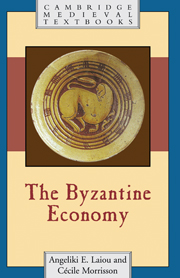Book contents
- Frontmatter
- Contents
- List of maps
- List of figures
- List of tables
- Acknowledgements
- List of abbreviations
- Introduction
- I Natural and human resources
- II The Late Antique economy and the shift to medieval structures (sixth–early eighth centuries)
- III Restructuring, recovery and controlled expansion (early eighth to tenth centuries)
- IV The age of accelerated growth (eleventh and twelfth centuries)
- V Small-state economics (from sometime in the thirteenth century to the fifteenth century)
- VI The Byzantine economy as exemplar; the Byzantine and the Western medieval economies
- Select bibliography
- Index
- Cambridge Medieval Textbooks
V - Small-state economics (from sometime in the thirteenth century to the fifteenth century)
Published online by Cambridge University Press: 05 June 2012
- Frontmatter
- Contents
- List of maps
- List of figures
- List of tables
- Acknowledgements
- List of abbreviations
- Introduction
- I Natural and human resources
- II The Late Antique economy and the shift to medieval structures (sixth–early eighth centuries)
- III Restructuring, recovery and controlled expansion (early eighth to tenth centuries)
- IV The age of accelerated growth (eleventh and twelfth centuries)
- V Small-state economics (from sometime in the thirteenth century to the fifteenth century)
- VI The Byzantine economy as exemplar; the Byzantine and the Western medieval economies
- Select bibliography
- Index
- Cambridge Medieval Textbooks
Summary
Problems of periodization challenge the historian of this broad period even more than of the ones preceding it. Because the Byzantine Empire had been an organized political unit that played a powerful role in the economy, economic developments were strongly affected by political ones. And they are dramatic: Constantinople fell to the members of the Fourth Crusade in 1204. This constitutes the first framing event of the thirteenth century. It resulted in the dissolution of the political space, never again reunited until the establishment of the Ottomans in Constantinople/Istanbul. There are, thus, powerful elements of discontinuity. Yet economic factors develop over the long term, and it takes a while for them to be affected by political events. So certain sectors of the economy (notably agriculture, but also pottery manufacturing) exhibit patterns of production and distribution similar to those of the earlier period, through the early part of the thirteenth century in the case of pottery production, until the late part of the century in the case of agriculture; others, like silk cloth manufacturing, declined early. Therefore, the dividing line between this period and the previous one depends on what aspect of the economy one examines. Some scholars have written of a “long thirteenth century” in Western Europe, hard to date because it is notional: it refers to “the temporal duration of a unique set of forces,” the forces of expansion. In Byzantium, the equivalent might be the “long twelfth century.”
- Type
- Chapter
- Information
- The Byzantine Economy , pp. 166 - 230Publisher: Cambridge University PressPrint publication year: 2007

